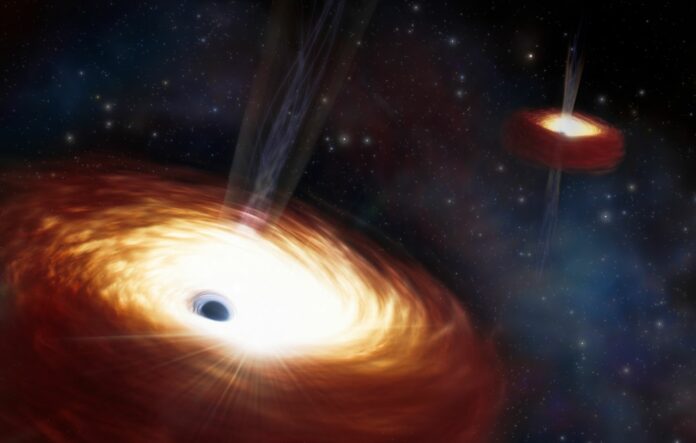In virtually all sizable galaxies, a supermassive black hole resides at its core. When two galaxies merge, their respective black holes can form a binary pair, indicating they orbit each other in a bound trajectory. The prevailing hypothesis suggests that these binary systems are destined to merge eventually, yet this phenomenon has never been directly observed.
Almost every big galaxy has a supermassive black hole in its core. When two galaxies merge, their black holes might form a binary pair, which means they are in a bound orbit around each other. It is predicted that these binaries would ultimately merge, although this has never been seen.
Astronomers have been discussing whether such an occurrence could happen for decades. A team of astronomers just released a study in The Astrophysical Journal that provides fresh insights on this subject.
Utilizing data obtained from the Gemini North telescope situated in Hawai‘i, a component of the International Gemini Observatory overseen by NSF’s NOIRLab and supported by the U.S. National Science Foundation, the research team scrutinized a supermassive black hole binary entrenched within the elliptical galaxy B2 0402+379.
This binary system stands as the sole instance where a supermassive black hole binary has been resolved with adequate detail to discern both entities distinctly. Remarkably, it boasts the distinction of possessing the smallest separation ever directly gauged, spanning a mere 24 light-years.
Despite the proximity implying an imminent merger, subsequent investigation unveils that the binary has remained stalled at this distance for over three billion years, prompting the question: What factors are causing this prolonged delay?
To further understand the dynamics of this system and its stalled merger, the researchers used archival data from Gemini North’s Gemini Multi-Object Spectrograph (GMOS), which enabled them to calculate the speed of stars around the black holes.
“The excellent sensitivity of GMOS,” adds co-author Roger Romani, “allowed us to map the stars’ increasing velocities as one looks closer to the galaxy’s center.”
With that, they “were able to infer the total mass of the black holes residing there.”
The team believes that the binary’s mass is 28 billion times that of the Sun, making it the heaviest binary black hole ever recorded. This measurement not only provides significant background for the binary system’s origin and the history of its host galaxy, but it also confirms the long-held hypothesis that the mass of a supermassive binary black hole plays an important role in preventing a merger.
According to Martin Still, NSF program director for the International Gemini Observatory, the data repository serves as a valuable resource for scientific discovery.
“Mass measurements for this extreme supermassive binary black hole are an awe-inspiring example of the potential impact from new research that explores that rich archive.”
Understanding how this binary evolved may help forecast whether or not it will merge, and many indicators point to the pair developing as a result of previous galaxy mergers. The first is that B2 0402+379 is a ‘fossil cluster,’ which means it was formed by the merger of an entire galaxy cluster’s worth of stars and gas into a single enormous galaxy. Furthermore, the existence of two supermassive black holes, paired with their vast combined mass, shows that they were formed by the merger of numerous smaller black holes from other galaxies.
Unraveling the evolutionary trajectory of this binary system holds potential in predicting its likelihood of merging, with several clues suggesting its formation stemming from prior galaxy mergers. Firstly, the designation of B2 0402+379 as a ‘fossil cluster’ indicates its genesis from the amalgamation of an entire galaxy cluster’s worth of stars and gas into a solitary colossal galaxy. Moreover, the presence of twin supermassive black holes, coupled with their considerable combined mass, implies their origination from the merger of numerous smaller black holes originating from disparate galaxies.
Armed with insights into the system’s immense mass, the research team calculated that an unusually extensive assemblage of stars would have been requisite to decelerate the binary’s orbit to its current proximity.
In the process, the black holes seem to have ejected almost all of the matter in their neighborhood, leaving the galaxy’s center devoid of stars and gas. With no more material available to slow the pair’s orbit, its union has reached its ultimate stage.
“Normally it seems that galaxies with lighter black hole pairs have enough stars and mass to drive the two together quickly,” remarks Romani. “Since this pair is so heavy it required lots of stars and gas to get the job done. But the binary has scoured the central galaxy of such matter, leaving it stalled and accessible for our study.”
It remains to be seen whether the duo will overcome their stasis and finally unite over millions of years, or whether they will remain in orbital limbo indefinitely. If they combine, the gravitational waves will be a hundred million times stronger than those generated by stellar-mass black hole mergers. It’s feasible that the pair may bridge that remaining gap via another galaxy merger, which would inject more material into the system, or a third black hole, slowing the pair’s orbit sufficiently to combine. However, considering B2 0402+379’s position as a fossil cluster, another galactic merger seems improbable.
“We’re looking forward to follow-up investigations of B2 0402+379’s core where we’ll look at how much gas is present,” adds lead author Tirth Surti. “This should give us more insight into whether the supermassive black holes can eventually merge or if they will stay stranded as a binary.”
Source: 10.3847/1538-4357/ad14fa
Image Credit: NOIRLab/NSF/AURA/J. daSilva/M. Zamani
